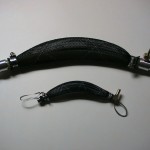Artificial Muscle Design and Modeling
Research Abstract:
 Fluidic artificial muscles have the potential for a wide range of uses, ranging from injury rehabilitation to high-powered hydraulic systems. Characterized by high power-to-weight ratios, relatively inexpensive fabrication, and natural compliance, artificial muscle are an interesting actuator for researchers. System level component relationships are currently being analyzed for high-efficiency novel robotics applications. Additionally, integration of variable recruitment and variable structure designs are being actively researched.
Fluidic artificial muscles have the potential for a wide range of uses, ranging from injury rehabilitation to high-powered hydraulic systems. Characterized by high power-to-weight ratios, relatively inexpensive fabrication, and natural compliance, artificial muscle are an interesting actuator for researchers. System level component relationships are currently being analyzed for high-efficiency novel robotics applications. Additionally, integration of variable recruitment and variable structure designs are being actively researched.
Publications:
- Jenkins, T., Chapman, E., and Bryant, M., “Bio-inspired online variable recruitment control of fluidic artificial muscles,” Smart Materials and Structures, 2016.
- Chapman, E., Jenkins, T., and Bryant, M. “Design and Analysis of Electrohydraulic Pressure Systems for Variable Recruitment in Fluidic Artificial Muscles,” Smart Mater. Struct., Vol. 27, No. 10, 2018.
- E. Chapman, M. MacLeod, and M. Bryant, “Electrohydraulic modeling of a fluidic artificial muscle actuation system for robot locomotion,” in Proc. ASME SMASIS 2015, Colorado Springs, CO, Sept. 21-23, 2015.
- Jenkins, T., Chapman, E., and Bryant, M., “Control approach development for variable recruitment artificial muscles,” Proc. SPIE Conference on Smart Structures and Materials: Active and Passive Smart Structures and Integrated Systems, April 15, Las Vegas, NV, 2016.
Researchers:
Project Funding:

